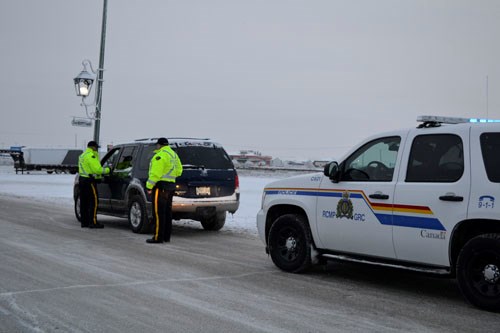Although she grew up in rural Saskatchewan- and was later posted to a rural RCMP detachment, Constable Allegra Howe of the Carlyle RCMP was surprised-and deeply concerned- to find that drivers were either disregarding or unaware of certain sections of the Traffic Safety Act.
“I grew up in rural Saskatchewan and I'm still surprised at the number of drivers who either don't know about-or disregard-the rules regarding emergency vehicles on our highways.”
Howe is referring to Section 204(1) of the Traffic Safety Act, which states that drivers should not exceed a speed greater than 60 km/hr when passing an emergency vehicle that is stopped on the highway with its emergency lights in operation.
Howe also adds that the best thing for drivers-in both highway lanes-to do if an emergency vehicle is approaching with its lights flashing is to pull over and stop so that first responders can get to their destination safely and quickly.
“It's even more important when we're dealing with winter driving conditions,” adds Howe.
Howe says her concerns about this issue prompted her to complete a months-long project in which she worked with fellow members of the Carlyle RCMP detachment, RCMP Traffic Services and Saskatchewan's Highway Transport Patrol in an effort to explore the extent of the problem and possible solutions.
“This type of project is one where new members of a detachment aim to find a project within their community that are often issues we identify, via 911 calls or general complaints.”
“For me, it started when I began pulling people over and doing traffic stops. And depending on the weather-especially now that winter's here-it can be very dangerous.”
“It really appalled me that people would not slow down-especially when it's someone identifiable like a police officer. But it made me think about how drivers react with other pedestrians, especially in this area, where we have many people often walking in sections of Hwy 9. And drivers have to be aware of other things on rural highways-there's wildlife, too.”
“Driving is not just getting from Point A to Point B. And it's still surprising to me when people speed by an emergency vehicle that is stopped, with its lights flashing, on the highway,” she adds.
“Is it that people don't know about the law or are they making a concious decision to disregard the law?”
Howe's report states that a recent blitz by police services throughout the province resulted in 478 charges laid against drivers speeding past emergency vehicles. During the month of November in this area, officers partnered in two separate traffic stops where they pulled over vehicles driving over 60km/hr when passing emergency vehicles with their emergency lights activated.
The report concluded that “When it was explained to people how dangerous it can be for officers to be out on the road with drivers that are not cognizant, choose to disobey, or do not know the laws, they were usually very understanding and apologetic. It was good to see that they could imagine a traffic stop from the perspective of a police officer and the safety concerns that come with it... At the end of each day, the public seemed to be responding and drivers speeding past officers were less frequent than earlier.”
“Anyone standing on the highway doesn't have much of a chance if a vehicle is going 60 km/hr, let alone the excessive speeds some people choose to go,” adds Howe.
Howe says that this section of the Traffic Safety Act regarding speed limits applies to all emergency responders. “This section and others applies to police, fire departments, EMS, Department of Highways personnel and even tow trucks on the job,” says Howe. “And I understand a lot of drivers don't realize this, especially as it pertains to tow trucks.”
“But really, ignorance of the law does not constitute a defence. One of the goals of this project was to inform, educate and motivate drivers and I do hope to raise more awareness in regards to passing emergency vehicles and slowing down in construction zones.”
“I used to be a flag person a long time ago. I've seen it from both sides and officers' safety is of the utmost importance, because we need to stay safe to keep the communities we serve safe.”



